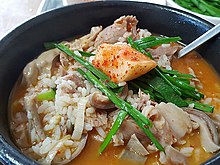Gukbap
 (pork and rice soup) with a cube of kkakdugi (diced radish kimchi) | |
| Place of origin | Korea |
|---|---|
| Serving temperature | Hot |
| Main ingredients | Guk (soup), bap (cooked rice) |
| Similar dishes | Noodle soup |
| Korean name | |
| Hangul | 국밥 |
|---|---|
| Revised Romanization | gukbap |
| McCune–Reischauer | kukpap |
| IPA | [kuk̚.p͈ap̚] |
Gukbap (국밥), hot soup with rice, is a Korean dish made by putting cooked rice into a hot soup or boiling cooked rice in a soup.[1][2] It is always in a black earthen pot bowl that preserves heat well.
Etymology[]
Gukbap is a compound of guk (soup) and bap (cooked rice).
Local Gukbap[]
The name of the gukbap varies from region to region.
Seoul and Gyeonggido
Seoul and Gyeonggido will offer Soondae or Somori gukbap if they order gukbap. Although they are not good at classifying rice with soup, seolleongtang is also famous.
Gyeongsang-do
Dwaeji-gukbap is famous in Busan. there are tremendous restaurant sells Dwaeji-gukbap.
Jeolla-do
Kongnamul-gukbaps are common in Jeonju-si, Jeolla-do. Within Jeolla-do, there are two kinds of rice soup. In general, Jeonju-Nam Market Gukbap, which does not boil, is common.
Varieties[]
- Dwaeji-gukbap (돼지국밥) – pork and rice soup.[3]
- Sogogi-gukbap (소고기국밥) – beef and rice soup.[4]
- Sundae-gukbap (순대국밥) – sundae (Korean sausage) and rice soup.[5]
- Kongnamul-gukbap (콩나물국밥) – kongnamul (soybean sprouts) and rice soup.[6]
- Gul-gukbap (굴국밥) – oyster and rice soup.[7]
- Siraegi-gukbap (시래기국밥) – siraegi (dried radish greens) and rice soup.[8]
- Ttaro-gukbap (따로국밥) – guk (soup) and bap (cooked rice) served in separate bowls.[9]
Similar dishes[]
Similar dishes outside Korea include the Chinese paofan and the Japanese ochazuke.
References[]
- ^ "gukbap" 국밥. Standard Korean Language Dictionary (in Korean). National Institute of Korean Language. Retrieved 27 March 2017.
- ^ "gukbap" 국밥. Korean–English Learners' Dictionary. National Institute of Korean Language. Retrieved 27 March 2017.
- ^ Seigis, Adrian (16 July 2015). "Busan and Hamburg - same but different". Korea JoongAng Daily. Retrieved 27 March 2015.
- ^ Lee, Khang Yi (22 March 2014). "Tasting Busan one step at a time,Part 2". Malay Mail. Retrieved 27 March 2017.
- ^ Byun, Duk-kun (16 December 2016). "(Yonhap Feature) Cheonan, a day trip to tradition and crucial part of Korean history". Yonhap. Retrieved 27 March 2017.
- ^ Ngamprasert, Chusri (1 June 2016). "Traditions make perfect". The Nation. Retrieved 27 March 2017.
- ^ Cho, Christine (23 February 2017). "[The Palate] Winter's oceanic jewels". The Korea Herald. Retrieved 27 March 2017.
- ^ Dynamic Busan (24 December 2016). "Mackerel – pickled, boiled or grilled to perfection". Stripes Korea. Retrieved 27 March 2017.
- ^ Sula, Mike (26 December 2016). "Delight in the belly of the beast at Pro Samgyubsal". Chicago Reader. Retrieved 27 March 2017.
- Korean rice dishes
- Korean soups and stews
- Korean cuisine stubs